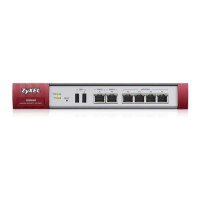107
1.5 How to Configure Ethernet, PPP, VLAN, Bridge
and Policy Routing
The following table describes when to configure the Ethernet, PPP, VLAN, Bridge screens under
Configuration > Network > Interface and the Configuration > Network > Routing > Policy
Routing screen.
Table 10 Ethernet, PPP, VLAN, Bridge and Policy Routing Screen Relationships
Configure this if any interface on the USG is connecting to an Ethernet network. Ethernet
interfaces are the foundation for defining other interfaces and network policies.
Configure this if you need your service provider to provide an IP address through PPPoE or PPTP in
order to access the Internet or another network.
Configure this if you want to divide your physical networks into multiple VLANs, or your service
provider or an aggregated network needs the USG to recognize the VLAN tags in the packets flowing
through the USG.
Configure this if you want the USG to combine two or multiple network segments into one single
network. Although the USG is “transparent” in this mode, you can still apply security checking on
packets flowing through the USG.
Configure this if you want to override the USG’s default routing behavior in order to send
packets through the appropriate interface or VPN tunnel.
Since firmware version 3.00, the USG supports IPv6 configuration in these Ethernet, PPP,
VLAN, Bridge and Policy Route screens under Configuration > Network > Interface and
Configuration > Network > Routing. Basically, these are the same as the ones for IPv4
networks except the following differences:
• You have to enable IPv6 globally in the CONFIGURATION > System > IPv6 screen to make the
IPv6 settings work.
• An Enable IPv6 setting - Select this in the screens listed above to enable the USG to be able to
send and receive IPv6 packets through the interface. Otherwise, the USG discards IPv6 packets
flowing through the interface.
• IPv6 Address Assignment - This section allows you to enable auto-configuration and configure
prefix delegation.
• DHCPv6 Setting - This section allows you to configure the DHCPv6 role and the corresponding
settings for the interface.

